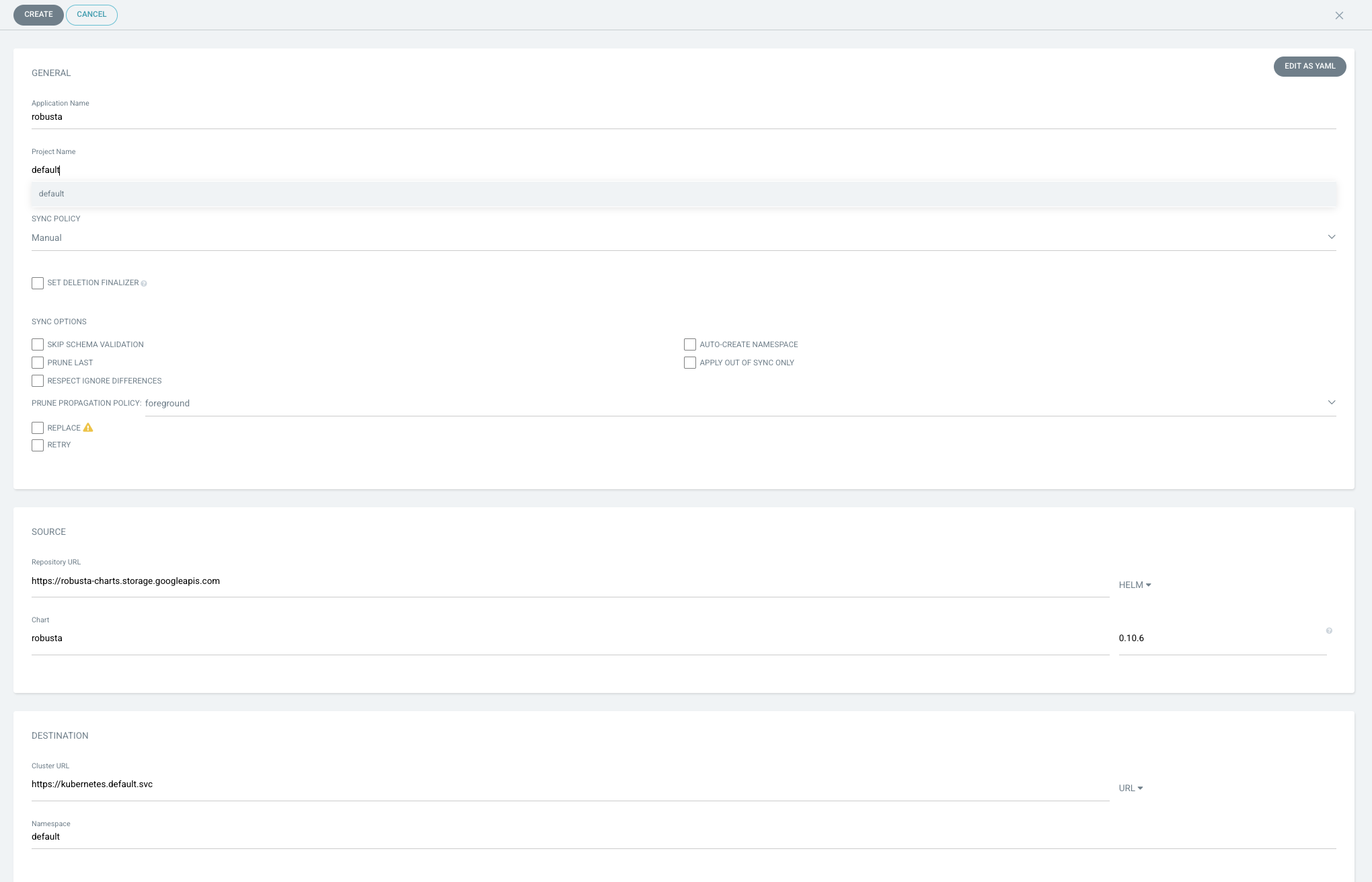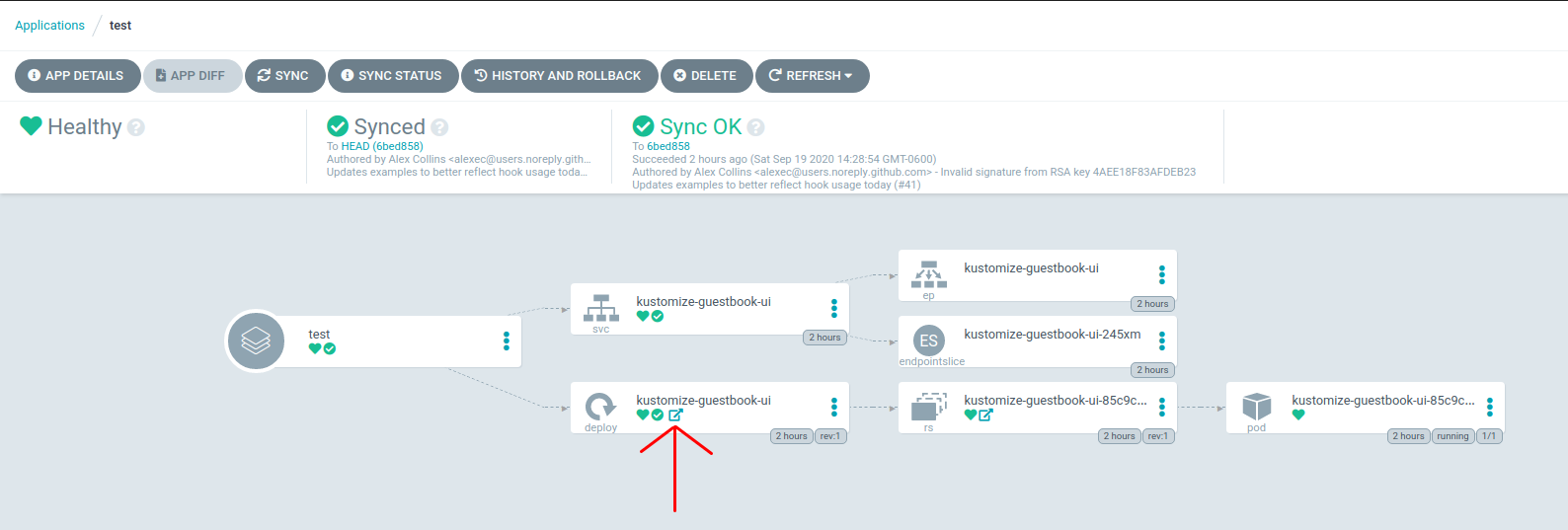Install with ArgoCD¶
This tutorial installs Robusta with ArgoCD.
Prerequisites¶
A Kubernetes cluster with ArgoCD
A
generated_values.yamlfile. Follow the Generate a Config tutorial to generate this.
Have questions?
Ask on Slack or open a GitHub issue
Preparing Robusta's config¶
Prepare your generated_values.yaml file for ArgoCD:
If it's not already present, add
clusterName: <YOUR-CLUSTER-NAME>If installing on a test cluster like KIND, add
isSmallCluster: true
Example generated_values.yaml:
clusterName: my_cluster_name # <- This is the line to be added
isSmallCluster: false # <- Optional. Set this on test clusters to lower Robusta's resource usage.
globalConfig:
signing_key: xxxxxx
account_id: xxxxxx
sinksConfig:
- slack_sink:
name: main_slack_sink
slack_channel: robusta-staging-alerts
api_key: xxxxxx
- robusta_sink:
name: robusta_ui_sink
token: xxxxxx
enablePrometheusStack: true
enablePlatformPlaybooks: true
runner:
sendAdditionalTelemetry: true
Secrets handling
Read this guide about Managing Secrets.
Configure ArgoCD in the UI¶
Create a NEW APP in ArgoCD and fill in the following settings.
General settings¶
Application name: Your choice (e.g "robusta")
Project name: Your choice (e.g "default")
Sync Policy: Your choice (we recommend starting with
Manual)
Source settings¶
Repository URL: https://robusta-charts.storage.googleapis.com
Chart: robusta
Change the dropdown box from "GIT" to "HELM"
Version: Choose the latest stable robusta version. (
-alphaversions are not recommended.)
Destination settings¶
To install robusta in the same cluster as ArgoCD, use the default https://kubernetes.default.svc option
Namespace: Your choice ("default" or "robusta" is recommended)
Here is a screenshot of all settings so far:

Directory settings¶
Change the "Directory" category to "Helm" by clicking the dropdown box.
Then paste the contents of generated_values.yaml into the values option.
Warning
Make sure you fill in values, not values files

Finish installing¶
Click the create button. Then choose all and press the sync button.
Finally, run robusta logs from your cli and make sure there is no error.

Sync fails
On some Robusta versions, the sync might fail with CustomResourceDefinition.apiextensions.k8s.io “prometheuses.monitoring.coreos.com” is invalid: metadata.annotations: Too long: must have at most 262144 bytes.
To solve it, use the workaround proposed here.
Configure ArgoCD Declaratively¶
First generate a Helm values file for Robusta, as described above. Put it in a Git repository and push it.
Then create an Argo Application which references that values file:
apiVersion: argoproj.io/v1alpha1
kind: Application
metadata:
name: robusta
namespace: argocd
finalizers:
- resources-finalizer.argocd.argoproj.io
spec:
destination:
server: https://kubernetes.default.svc
namespace: robusta
project: default
sources:
- chart: robusta
repoURL: https://robusta-charts.storage.googleapis.com
targetRevision: <ROBUSTA VERSION - e.g. "0.10.31">
helm:
valueFiles:
# this refers to the repository defined below containing your value files
# see https://argo-cd.readthedocs.io/en/latest/user-guide/multiple_sources/#helm-value-files-from-external-git-repository
- $values/values/robusta.yaml
- repoURL: "git@github.com:my-user/example-repo.git"
targetRevision: HEAD
ref: values
Configuring Argo Links¶
For faster Kubernetes troubleshooting, add Robusta links to ArgoCD.

Add an annotation to each Kubernetes resource with Robusta's URL:
apiVersion: apps/v1
kind: Deployment
metadata:
name: my-deployment
annotations:
link.argocd.argoproj.io/external-link: "https://platform.robusta.dev/"
Or link applications to their specific Robusta pages:
apiVersion: apps/v1
kind: Deployment #workload type
metadata:
name: my-deployment #workload name
annotations:
link.argocd.argoproj.io/external-link: "https://platform.robusta.dev/?namespace=%22default%22&type=%22Deployment%22&name=%22some-deployment%22&cluster=%22robusta-cluster-name%22"
What is the right Robusta URL for each application?
It's easiest to open the workload in RobustaUI and copy the URL from the browser.
You can also build the URL by hand. Edit the above URL, replacing:
defaultwith the workload's namespaceDeploymentwith the workload type. Ex:StatefulSetssome-deploymentwith the workload's name. Ex:my-deploymentrobusta-cluster-namewith your cluster's name, as defined in the Robusta Helm valueclusterName
For more details, refer to the Argo Documentation on External URLs.